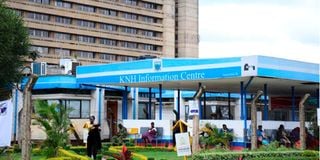Premium
KNH performs first technology-assisted kidney transplant

Kenyatta National Hospital in Nairobi.
Dickens Njoroge (36) is now looking forward to a pain-free future after becoming the first Kenyan to receive a kidney from his cousin and best friend, Dickson Gakei (35), through a new type of surgery that is set to revolutionise kidney care in the country.
On Thursday, surgeons at Kenyatta National Hospital (KNH) announced that they had performed the first successful minimally invasive kidney transplant, known as laparoscopic or keyhole surgery, on Njoroge, who has been battling kidney disease.
This is thanks to recent developments in the field of urological surgery, with advances in engineering and computer technology, and a team of doctors led by Dr Charles Waihenya and Dr Paul Njogu, the head of the Renal Unit at KNH.
Chronic kidney disease (CKD), also known as chronic kidney failure, is the gradual loss of kidney function.
The kidneys filter waste products and excess fluids from the blood, which are then excreted in the urine.
CKD can cause dangerous levels of fluid, electrolytes and waste to build up in your body.
The surgery is a significant achievement because in the past the most common treatment was open surgery, which results in longer healing times and leaves both the donor and recipient with large scars after surgery.
“The National Hospital Insurance Fund (NHIF) paid for me about Sh400,000 and I just deposited Sh300,000,” Njoroge told the Nation.
The KNH doctors explained that during laparoscopic surgery, the doctor makes a series of small incisions in the patient's lower abdomen and inserts a tiny tube with a light and camera (a laparoscope) to access the kidney.
The surgeon then navigates and inspects the region on a TV-like monitor that receives images from the camera.
Once in place, the surgeon can now visualise the tissue, biopsy suspicious areas, remove tumours or even remove the kidney using a cutting and tissue retrieval instrument that is also part of the laparoscope.
The surgery involves making incisions up to 30 centimetres long just below the ribs, in some cases requiring the removal of a rib, and later closing the incision with stitches, they added.
But how did Njoroge get to be the first Kenyan on the operating table for this new type of surgery?
His cousin, Gakei, who donated his kidney, said: “When doctors found out that I was eligible to donate one of my kidneys after a series of tests, I was told of a new type of transplant known as laparoscopy, which is minimally invasive and is aided by technology. They assured me that I would heal in no time and resume my business as usual.”
According to the KNH, at least five million Kenyans are currently living with kidney disease but most are unaware of their condition because the symptoms don’t show up immediately.
“7,000 Kenyans are currently undergoing renal dialysis with the majority relying on the NHIF cover to cushion them from the adverse cost of treatment. A session now costs Sh6,500 down from Sh9,500,” KNH said, adding that while renal dialysis is a step in the right direction, a kidney transplant is often more suitable to treat the condition.
In an interview, Benjamin Wambugu, a nephrologist, revealed that every county has a 5-bed dialysis centre that is covered by NHIF.
“This means that not everyone has access to the service. Dialysis is a lifesaving treatment but comes at a cost and so transplantation is the way to go, although the current challenge is the availability of donors and the cost of treatment,” he said.
Dr Waihenya urged Kenyans to go for regular kidney check-ups every four to six months.
He also assured patients that recovery time is much better with laparoscopy than with open surgery.
“In laparoscopy, we divide the muscles into two and after the surgery, within 24 hours, one can go home,” he said.
The expert said the burden of kidney disease is not only being felt by those who suffer from it, but also by their loved ones.
Meanwhile, Dr Njogu pointed out that as much as there has been positive progress in the treatment of kidney disease, more can be done.
“Since 2010, we have transplanted at least 250 patients and our patients have been doing well...we have been following them up and at the moment we are able to do one transplant every week...Yes, we have not reached where we want to be, [as] we would like to be transplanting at least two patients every week,” he said.
Some of the symptoms of kidney disease to look out for are hypertension or high blood pressure, nausea, vomiting, muscle cramps, loss of appetite, swelling of the feet and ankles, shortness of breath, trouble sleeping, urinating either too much or too little and waking up with a swollen face.





